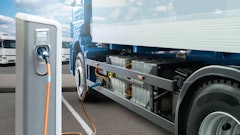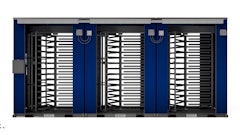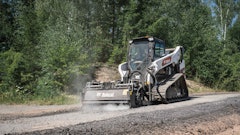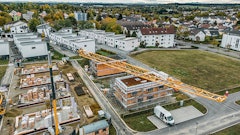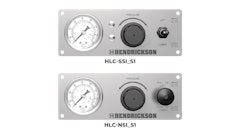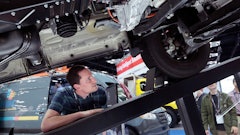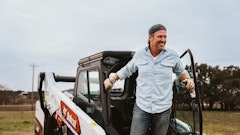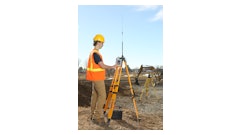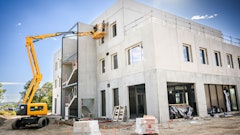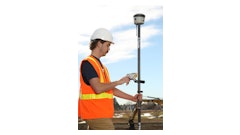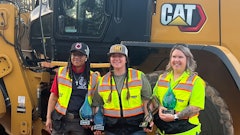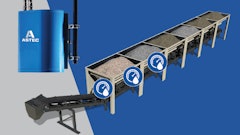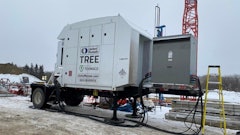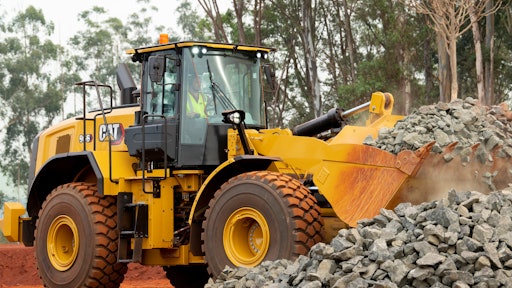
Choosing the right bucket attachment for the soil and aggregate type on a jobsite to get the best use out of a wheel loader pays off in productivity as well as reduced operating costs for contractors and their clients.
While doing so is considered desirable under any circumstances, it is particularly critical at the present time, when the labor force has gone through disruption and the economy demands the best return on investment.
Scott Schmidtgall, Caterpillar medium wheel loader product application specialist, North American region, notes there are several different types of buckets to meet various application needs.
“Spade rock buckets offer a solution for harsh digging applications like at a quarry face with shot rock, whereas light material buckets are larger volumes intended for lighter material use like wood chips,” he says. “General purpose buckets are typically used for soil/aggregate type use with a bolt-on cutting edge.”
The two primary factors that should be considered in mounting a bucket to a front-end loader for material handling are the material density and the material type, notes Nathan Repp, Komatsu product marketing manager.
Making the right choice in a bucket attachment for a front-end loader encompasses the consideration of factors such as durability, capacity, weight, and costs, Repp points out.
“The bucket must be made to last through the abrasion, vibration, and stress of severe use while not being so heavy that the amount of material picked up is extremely limited, and be priced competitively,” he adds.
“For loose, high organic matter content, the size or volume capacity of the bucket can be much larger, and this is where our light material buckets come into play. Materials like wood chips, silage, loose loam, and similar materials will take up much more volume to reach the same tipping point compared to denser materials like sand or gravel. For heavier materials, the choice would be the general purpose – or excavating buckets – with heavier structures and reinforcements.”
If the type of material the loader will be expected to handle changes often, a quick attach coupler bucket will be the best choice as it enables the operator to quickly switch between the general-purpose style bucket for dense material and a light material bucket for high volume media, says Repp.
“Excavating buckets are heavier duty to withstand the hard use of digging out compacted rock and soil, and typically include excavation teeth to help bite into and loosen the material,” Repp notes. “If the loader will focus on a specific task, then the choice of bucket can be a pin-on style that will allow for the operator to move the maximum amount per pass.”
Newer bucket designs that have come onto the market also have increased bolsters to help retain the material and prevent spillage, thereby maximizing efficiency and reducing the number of required cycles to complete a load-out operation, Repp notes.
Capacity is a critical consideration, notes Ethan Clowes, JCB product manager for wheel loaders, skid steer/compact track loaders and backhoe loaders.
“To be as productive as possible, you want to move as much material as you can but in a safe and efficient way,” he points out. “Use the payload of the machine and the density of the material being used to find the perfect bucket capacity. “
Luke Gribble, John Deere solutions marketing manager, says when selecting a bucket attachment for soil and aggregate applications, a traditional construction bucket is one option to consider as it offers a low profile backplate for better visibility to the cutting edge and a rounder interior designed for excellent fill and dump performance.
A tooth bucket serves as another option, he adds.
“This bucket type is especially good for loosening compacted soil or for grubbing out rocks, in addition to offering better penetration when going into a pile,” he says. “Despite having teeth, this bucket still maintains a flat bottom, making it an excellent tool for back-dragging as well.”
Gribble points out once a contractor has narrowed down the type of bucket category that fits best with the needs of the jobsite, choosing the proper bucket size is a must.
“If your goal on site is to move dirt as quickly as possible, consider adding a lighter bucket to your machine to lessen the risk of slower operating speeds,” he adds. “If versatility is a priority, a bucket with a quick coupler would be ideal to allow your team to quickly switch between different attachments.
“Additionally, consider where you are loading your materials. As an example, some operators might need to reach a certain bucket height requirement.”
Schmidtgall points out that looking at the work application one is expecting a machine to perform is key when considering a bucket attachment type.
“For example, what are the production demands and material densities that need to be moved,” he notes. “Even differing moisture contents can affect the weight of the material. The weight of the material affects the bucket size that is reasonable to move with the machine. A properly-sized bucket can help increase efficiency of the machine and the operator.”
A bucket that is too large for a machine and the material it is being used in can affect cycle time in the dig as well as machine stability when moving material, Schmidtgall says.
“Longer dig times means higher fuel burn as the dig portion of a loader’s cycle is the highest instantaneous fuel burn of a loader’s cycle,” he adds. “If a bucket is sized too large for the material density this can affect machine stability, which can cause an operator to need to slow down his cycle times.”
“Sizing a bucket so an operator can target full passes helps improve efficiency as well,” says Schmidtgall.
He points out considering what the majority of the material that is expected to be moved is key in sizing the machine as well as the bucket for the application.
“This can greatly affect machine model size,” he adds. “Why purchase or size a larger machine with a larger bucket only to have lower utilization on it? If one can balance a reasonable idle time along with work time to help increase their utilization, this can help lower the costs since it may help highlight a smaller model bucket size versus a larger model bucket that gets the work done faster and then has lower utilization and higher idle time.
‘Additionally, in knowing whether the target applications the loader is expected to do is beyond just bucket work that needs to be performed, consider fork work or material handling. This can help determine whether a pin-on bucket is feasible or whether a coupler bucket would be more adequate. However, when you start adding a coupler. this is additional weight that needs to be moved every cycle for the loader.’
Corner guards, side protectors and heal plates to protect higher wear locations can extend the life of a bucket and its cutting edges. There are different types of wear packages to be considered, says Schmidtgall.
“Standard, abrasion or heavy-duty type wear packages should be used appropriately so you can drive as much efficiency as possible,” he adds. “For example, if you outfit a bucket with wear material for a highly abrasive heavy-duty environment where that protection isn’t needed, you’re potentially sacrificing efficiency in many areas.
“Additional wear material means a heavier bucket, which sacrifices ‘live’ payload for that loader. It can mean using more fuel per cycle to lift that additional wear material and certainly can affect the bucket size that you should be using depending on your material densities.”
Other site conditions such as dump clearances, width constraints, and loading style preferences can all affect the type, size and style of bucket to be used, notes Schmidtgall.
He recommends the use of spill guards to help protect material dribbling over the back of the bucket and down the linkage arms.
There are a number of challenges contractors either seek to mitigate or avoid when making the most appropriate choices of matching a bucket type to a wheel loader when taking material type into consideration.
“Improperly sizing a loader – loading tool – to a truck can be detrimental in obtaining efficiency on a jobsite,” says Schmidtgall. “There are many items to consider in making a decision on what bucket size as well as loading height constraints that need to be met.”
Knowing what current actual production targets are as well as what the future production is intended to be is critical, he adds.
“Material density, production targets, peak times, realistic idle times all come to mind very quickly as areas that cause pain if they aren’t understood well,” he adds. “Items like underfoot conditions so you consider the correct traction aides required for the application as well as height and width constraints so you make sure your loader will fit the other tools on site that it interacts with are critical as well.”
Additionally, one should consider the hauling unit payload targets, says Schmidtgall.
“As an example, moving clean washed stone (2550 lb/cyd) could easily be done with a 982 outfitted with 9.8 CYD GP bucket if loading a 24-ton truck, but we are seeing often – whether from special permitting or increased allowances – that contractors are able to load up to 26 tons or even more.”
Schmidtgall says that could easily be managed with a 982 configured with a 10.8 CYD GP bucket to keep production up loading two passes on each truck.
“A 9.8-yard bucket would not allow the capacity to hold enough material to two pass since it is such a light density, forcing the operator to three pass (two and a partial),” he adds.
“This will hinder production demands hugely during peak times. If production demands don’t deem two passing that material, then bigger questions such as considering downsizing to perhaps not just a model size down, but more strategically down two model sizes to a 972M Aggregate Handler with a 7.25 CYD GP bucket which can more efficiently load out three pass 26-ton trucks if the production targets don’t demand more.”
OEMs such as Komatsu use engineering calculations to help contractors meet those challenges by determining the best match of a bucket’s capacity and the density of the material together with the wheel loader’s lifting capacity and tipping point, says Repp.
“This free analysis by Komatsu can be used to determine which bucket best matches the required use,” he adds. “Other factors like the abrasive quality of material and whether it is loose or compacted will help determine the necessary style and design of the attachment.”
Choosing the right bucket capacity ensures the machine is not overloaded with the material and is being used to its maximum potential, Clowes notes.
“If an incorrect bucket capacity was selected, the machine may become unstable and the operator would have to slow down,” he says, adding that doing so will make the work much less efficient.
Utilizing the correct bucket for the main type of application for which they seek to use the bucket goes a long way to mitigate challenges and avoid potential problems, says Gribble.
“The use of a construction or tooth bucket is a great option when handling soil or aggregates,” he says. “However, these may not be the best solutions for other applications. Light material buckets or utility buckets are other options that can be used on compact wheel loaders.
“These buckets are designed with some of their weight removed to handle higher quantities of materials more efficiently like wood chips, sawdust, snow, grain, fertilizer, or other low-density materials.”
Gribble points out another option to consider is a rollout bucket, “which is ideal to equip on a loader if a contractor is trying to achieve some additional dump height – especially in high-capacity applications like agriculture, forestry, demolition, and recycling.”
The user-friendliness involved in the ability to attach the bucket to a wheel loader and execute the task properly is key to obtaining optimal productivity from a jobsite crew.
Clowes and other manufacturers note construction equipment has become easier to use as technology advances machine features, but training and experience is still required to get the most out of a wheel loader.
For loaders equipped with quick couplers, a simple process for changing between attachments is outlined in the operators’ manual. It does not require the operator to leave the operator station unless there are auxiliary hydraulic circuits, which allows for seamless attachment changes when handling multiple material types, Repp points out.
“While there is professional training available, the process is straightforward and does not require formal training, allowing operators to perform the operation quickly after just a couple repetitions,” he adds.
“Newer buckets have improved load floor and curvature design to make getting a fully- heaped bucket on each pass easier and more efficient. Spade nose buckets have an aggressive cutting-edge design with teeth allowing for easier penetration into hard-packed or dense materials, making loading easier and faster.”
As bucket attachments are a valuable tool for the worksite productivity, operators often take into consideration whether the equipment should be purchased outright or rented on an as- needed basis.
The decision to purchase or rent an attachment can be determined based on how much use the operator is looking to get out of the attachment and loader combination, Repp points out.
“For special applications where certain types of attachments are required and the task is for a short-term duration, renting can be a viable option,” he adds. “However, if the total cost of ownership is spread out over the life of the machine, then the return on investment will be in the owner’s favor if the attachment is purchased as the life of the loader and attachment can be expected to far exceed the length of a rental term.”
“Generally, if you use the machine every day/week, then buying is almost always going to be more cost effective,” Clowes concurs. “If you only require the machine a few times a month, renting a machine would work out more cost effective and you don’t have to worry about maintenance and other associated costs of owning a wheel loader.”
When deciding whether to rent or buy a piece of equipment, it is important to first consider what type of material is needed to move on a jobsite, notes Gribble.
“Operators should also consider the type of terrain and areas the buckets would be used in,” he adds. “Rollout buckets can lift materials from tight spaces with precision and accuracy. Would this application be helpful on most jobsites your company works on or is this application a one-off project?
“An operator should consider renting attachments on an as-needed basis. Renting attachments is a great way for professionals to complete a variety of applications based on the job, increasing machine versatility.”
Whether a contractor rents or buys equipment, it’s important to read the owners’ manual to understand how to best use the machine, and ensure they are conducting the necessary maintenance intervals on the attachment to achieve an extended lifespan, Gribble says.











